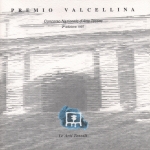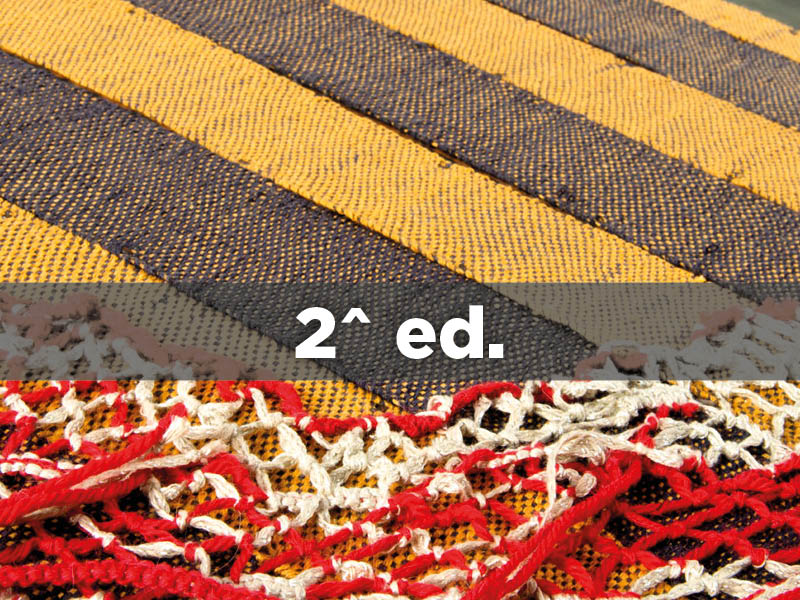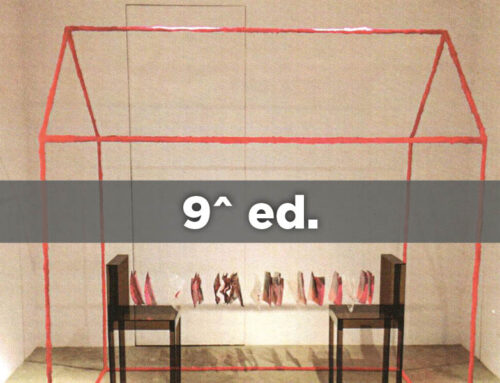1997/1998
Premio Valcellina, Concorso Nazionale d’Arte Tessile, 2^ edizione
Valcellina Award, National Textile Art Competition, 2nd edition
Concorso rivolto a tutti i giovani artisti tessili di età inferiore ai 30 anni, residenti in Italia
Competition open to all young fiber artists resident in Italy and under 30 years of age
Chiusura del bando 30 maggio1997
Artisti 54 partecipanti, 52 selezionati ammessi al concorso
Inaugurazione e cerimonia di premiazione 18 gennaio 1998, Ex-Filanda, Maniago PN
Durata dell’esposizione dal 19 gennaio al 1° marzo 1998
Eventi successivi
Dal 21 al 26 aprile 1998, una selezione delle opere ha partecipato alla 1^ rassegna del Progetto Hyphen che si è tenuto a Kunsthaus Rhenania [Casa dell’Arte della della Renania], Colonia, Germania
Deadline for participation 30 May 1997
Artists 54 participants, 52 selected and admitted to the competition
Inauguration and award cermony 18 January 1998, Ex-Filanda (Ex-Spinning mill), Maniago PN
Exposition period from 19th January to 1st March 1998
Subsequent events
From April 21st to 26th 1998, a selection of the works participated at the 1st review of Hyphen Project, which was held at Kunsthaus Rhenania (Rhenania Art House), Cologne, Germany
Giuria / Jury
Carlo Ciussi – Artista / Artist
Carlo Clocchiatti – Gallerista / Gallery owner
Maria Masau Dan – Direttrice del Museo d’Arte Moderna Revoltella di Trieste / Director Museo d’Arte Moderna Revoltella (Museum of Modern Art), Trieste
Lydia Predominato – Artista tessile / Textile artist
Stefania Severi – Critico d’arte / Art critic
Artisti selezionati, opere e premi assegnati
Selected artists, works and prizes awarded
PRIMO PREMIO / FIRST PRIZE
Vania Falcomer La vita è un intreccio, il pensiero è un nodo / Life is a plot, thought is a knot
SECONDO PREMIO / SECOND PRIZE
Antonio Ranalli Memoria di Magna Grecia / Memories of Magna Graecia
TERZO PREMIO / THIRD PRIZE
Eleonora Censorii Occhio tellurico / Telluric eye
PREMIO SPECIALE / SPECIAL PRIZE FRIULI VENEZIA GIULIA
Anna Fadini Ritmos [Ritmi] / Rhythms
MENZIONE SPECIALE / SPECIAL MENTION
Yolanda Carmona Arellano Sfere di senso / Spheres of meaning
Angela Fazzari Cappello medusa / Medusa hat
Fabiana Sala Patchworld. Ma che cosa è successo? / Patchworld. What has happened?
MENZIONE SPECIALE / SPECIAL MENTION CIRCOLO CULTURALE MENOCCHIO
Maria Vittoria Sargentini L’impermeabile / The raincoat
—
Giulia Acciardi La cintura di Calypso / Calypso’s belt
Katiuscia Albanese L’isola che non c’è / Neverland
Loretta Ambrosig La parte razionale del mio io / The rational side of my Ego
Alessandra Arosio Tessere la vita / Weaving life
Mariagrazia Bernardis La palma della vita / The palm of life
Lorenza Boisi Fortinbras II – L’uomo del destino / Fortinbras II – The man of fate
Cristiano Carciani Bambolona in minigonna / Large doll in a mini-skirt
Linda Donati Alberi / Trees
Monica Dreossi Il mare / The sea
Luisa Gentili Tra terra e cielo / Between earth and sky
Romina Giglio Preacher: il predicatore / The preacher
Mi Kyung Han Sogni irrealizzati / Unfulfilled dreams
Massimo Lattanzio Fiamma nel vento / Flames in the wind
Agata Lesniakowska Le rivali / The rivals
Clara Luiselli Rivelazioni / Revelations
Federica Luzzi Vento / Wind
Maya Meidar Fuori dal muro / Outside the wall
Flavia Michelutti Mani / Hands
Alon Moran Superficie e quadrati / Surface and squares
Daniela Negro Vita / Life
Nina Nemec Due volti in una luce misteriosamente umana / Two faces in a mysterious human light
Lucia Pagliuca Via lattea / Milky Way
Cristina Ruggiano Il silenzio / Silence
Paola Tovazzi Immaginazione / Imagination
Saggio critico / Critical essay
Mesci, odorosa Dea, rosee le fila di Stefania Severi, critica d’arte, giuria Premio Valcellina 2^ edizione
Il più bel velo di cui si abbia notizia e certo quello che, per le Grazie, tesserono e ricamarono le Dee dell’Olimpo: le Ore distendevano l’ordito, le Parche ordinavano la trama, Psiche raddensava la tela col pettine e Flora ricamava.
<<Mesci, odorosa Dea, rosee le fila… Or mesci, amabil dea, nivee le fila… Mesci, madre dei fior, lauri alle fila…>> cosi il Foscolo nel III Inno del suo poema Le Grazie.
L’arte tessile è da sempre legata all’immaginario femminile, anche se molti uomini vi si sono dedicati, anche in antico. Forse ciò si è verificato perché essa richiede quelle doti di pazienza e di dedizione tenace che vengono indicate come peculiari della donna. L’arte tessile è stata posta sotto la protezione di Pallade, che è Dea non solo delle arti femminili ma anche della guerra di difesa e dell’intelligenza. La complessità dei ruoli della Dea e testimonianza dell’importanza, pratica ma soprattutto simbolica, che essa rivestiva, e, oserei dire, riveste, come espressione di quella difesa dei valori che dalla famiglia si amplia ad includere la difesa della collettività civile.
Arte difficile, quella della tessitura, che richiede, oltre alla bravura tecnica, delle doti di spiccata creatività quando si vuole che il prodotto assurga dal piano artigianale a quello artistico. Arte non “minore”, anche se da troppo tempo la storia dell’arte l’ha relegata in una sorte di appendice, etichettandola in modo riduttivo. Ma basti pensare ad opere quali la Tapisserie de Bayeus o al paramento della Dame à la licorne perché quell’indicazione “minore” ceda il posto a quella di capolavoro.
Nell’ultimo secolo l’arte tessile ha subito profondi cambiamenti, in stretta relazione con i cambiamenti e del quadro economico-sociale e del panorama delle arti figurative. Se ciò da un lato ha comportato una drastica riduzione di coloro che vi si dedicano, dall’altro ha rafforzato, in coloro che l’hanno scelta come mezzo espressivo, la consapevolezza che il loro prodotto è, a tutti gli effetti, artistico, perché sottratto alla logica della ripetitività e dettato dall’urgenza di un discorso personale su base creativa. E’ cosi nata la Fiber Art, una forma “trasversale” di espressione artistica che usa come mezzo espressivo il filo (di paglia, metallo, plastica, lana, spago, seta, cotone, lana di vetro, fibre ottiche…) utilizzando tecniche tipiche della tessitura, quali l’intreccio di trama ed ordito, ma anche la stampa, il ricamo, il nodo, il collage, il ready-made… . Forma trasversale perché attinge a suggestioni che vanno dal Futurismo (e come non ricordare gli arazzi di
Fortunato Depero, per altro eseguiti con uri paziente lavoro di cucitura a mano dalla moglie Rosetta che spesso ne interpretava liberamente i bozzetti) all’Astrattismo, con riferimenti tanto all’Astrattismo Geometrico che all’Astrattismo tout court fino a giungere all’informale. Ma ancora alcune opere possono essere indicate come Arte Povera, in riferimento alla sintesi segnica alla ricerca degli archetipi, o come Concettuale. Alcuni prodotti possono essere infine ricondotti alle tematiche Pop, specie nell’utilizzo di materiali industriali di largo consumo variamente enfatizzati. Tale complessità di modelli di riferimento, se da un lato può sembrare deviante, dall’altro inserisce la Fiber Art nel più ampio dibattito artistico.
Il qualificarsi per lo specifico, quindi, se da un lato può sembrare riduttivo, dall’altro rafforza, negli artisti che vi si riconoscono, una specificità che ne sottolinea le peculiarità. E’ pertanto auspicabile che si conservino e si puntualizzino quegli elementi tipicizzanti, già da Foscolo poeticamente individuati, così che, rinnovandosi
ancor oggi il velo delle Grazie, si trovi sempre un’altra Dea alla quale esortare <<Mesci, o Flora gentile, oro alle fila… Mesci cerulee, Dea, mesci le fila…>>.
Pour, scented Goddess, the rose-hued threads by Stefania Severi, art critic, jury member of Valcellina Award 2nd edition
The most beautiful veil that has ever been spoken of, is certainly the one which the goddesses of Olympus weaved and embroidered for the Graces: the Hours stretched out the warp, the Fates arranged the weft, Psyche beat in the rows of yarn with her comb, and Flora embellished further by embroidering. <<Pour, scented Goddess, the rose-hued threads… pour, good-natured goddess, the snowy filaments… blend, mother of flowers, the laurel row …>> as Foscolo wrote in the third Hymn of his poem The Graces. Textile art has most recently been associated with women, and the female imagination, although many males have dedicated themselves to these arts as well, even in ancient times. Perhaps this association (with the feminine sphere) has occurred because the skills of weaving and embroidery require those qualities of patience and tenacious dedication, often inferred as peculiar to women. Textile arts were under the protection of the goddess Pallas, who was goddess not only of the “female” arts, but also of War, Defense and Intelligence. The complexity of the roles Pallas held, and testimony to the practical and symbolic importance given to the latter role – in the past and still today – is the fact that Pallas is protector of the value of family, extended to include the defence of the entire community. Difficult art, that of weaving, which requires technical skill as well as marked creativity when the product is to rise from the artisan to the artistic level. Textile Art cannot bee seen as a “lesser” form of art, notwithstanding that, for too long in the history of art, its destiny has seen it relegated to a mere artistic addendum. We need do no more than observe and reflect upon the Bayeux Tapestry, or the robes of The Lady and the Unicorn, that such a “lesser” appellation gives way to a reaction of awe at the utter mastery required to produce the works. Over the last century, textile arts have undergone profound innovations, along with transformations in the economic and social frameworks governing the panorama of figurative arts. If these changes, on the one hand, have led to a drastic reduction in the numbers of people whose lives are dedicated to working in these arts, by contrast, they have strengthened the conviction of those who have chosen textile arts as a means of expression, that this work is, to all effects, amongst the highest forms of art, because it is anything other than governed by considerations of mere functionality, and instead, dictated by the exigencies of intimate discourse and creativity. So Fiber Art has was born, employing a cross-section of artistic expressions, that uses wire, straw, metal, plastic, wool, twine, silk, cotton, glass wool, and optical fibres, employing the typical techniques of weaving (with warp and weft), print, embroidery, knotting, collage, and ready-made materials across the board drawing on influences that range from Futurism (recalling the tapestries of Fortunato Depero, realised with indefatigably meticulous stitching by his wife Rosetta, who often interpreted his sketches liberally) to Abstractism, with references to both geometric abstractionism and tout court abstractionism, to the Informal. However some works may still be referred to as Arte Povera, with reference to symbolic synthesis in the search for archetypes, or others still, as Conceptual Art, and certain others can be traced back to Pop themes, due to the adoption of widely-used industrial materials. This complexity of modes of reference, on one hand seemingly deviant, contrarily ushers Fiber Art into wider artistic debates. Qualification for the specific, therefore, may be perceived as reductive, yet reaffirms in those Fiber artists who recognize themselves as such, a specificity that emphasizes its own peculiarities. It is therefore of fundamental importance that these traditional elements, having already been immortalised by Foscolo in his poetry, be preserved and emphasised, so that, even in modern times, one undertaking to restore the veil of the Graces, is sure to be able to find a modern-day Goddess to whom to exhort: <<Oh gentle Flora, pour gold into the threads… pour heavenly blue, goddess, pour the yarns…>>.








